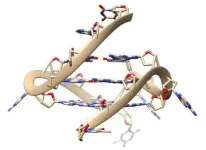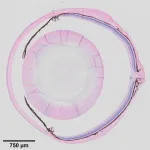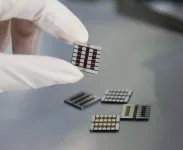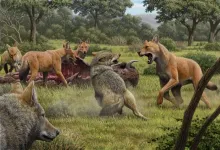Compound from medicinal herb kills brain-eating amoebae in lab studies
2021-01-13
(Press-News.org) Primary amoebic meningoencephalitis (PAM), a deadly disease caused by the "brain-eating amoeba" Naegleria fowleri, is becoming more common in some areas of the world, and it has no effective treatment. Now, researchers reporting in ACS Chemical Neuroscience have found that a compound isolated from the leaves of a traditional medicinal plant, Inula viscosa or "false yellowhead," kills the amoebae by causing them to commit cell suicide in lab studies, which could lead to new treatments.
PAM, characterized by headache, fever, vomiting, hallucinations and seizures, is almost always fatal within a couple of weeks of developing symptoms. Although the disease, which is usually contracted by swimming in contaminated freshwater, is rare, increasing cases have been reported recently in the U.S., the Philippines, southern Brazil and some Asian countries. Amphotericin B is the most common therapy given to those with the infection. It can kill N. fowleri in the lab, but it isn't very effective when given to patients, likely because it cannot cross the blood-brain barrier. Ikrame Zeouk, José Piñero, Jacob Lorenzo-Morales and colleagues wanted to explore whether compounds isolated from I. viscosa, a strong-smelling plant that has long been used for traditional medicine in the Mediterranean region, could effectively treat PAM.
The researchers first made an ethanol extract from the herb's leaves, finding that it could kill N. fowleri amoebae. Then, they isolated and tested specific compounds from the extract. The most potent compound, inuloxin A, killed amoebae in the lab by disrupting membranes and causing mitochondrial changes, chromatin condensation and oxidative damage, ultimately forcing the parasites to undergo programmed cell death, or apoptosis. Although inuloxin A was much less potent than amphotericin B in the lab, the structure of the plant-derived compound suggests that it might be better able to cross the blood-brain barrier. More studies are needed to confirm this hypothesis, the researchers say.
The authors acknowledge funding from the European Regional Development Fund, the Spanish Ministry of Economic Affairs and Digital Transformation, the Spanish Ministry of Science, Innovation and Universities, the University of La Laguna and the Augustin de Betancourt Foundation.
The abstract that accompanies this paper is available here.
INFORMATION:
The American Chemical Society (ACS) is a nonprofit organization chartered by the U.S. Congress. ACS' mission is to advance the broader chemistry enterprise and its practitioners for the benefit of Earth and its people. The Society is a global leader in providing access to chemistry-related information and research through its multiple research solutions, peer-reviewed journals, scientific conferences, eBooks and weekly news periodical Chemical & Engineering News. ACS journals are among the most cited, most trusted and most read within the scientific literature; however, ACS itself does not conduct chemical research. As a specialist in scientific information solutions (including SciFinder® and STN®), its CAS division powers global research, discovery and innovation. ACS' main offices are in Washington, D.C., and Columbus, Ohio.
To automatically receive news releases from the American Chemical Society, contact newsroom@acs.org.
Follow us: Twitter | Facebook
[Attachments] See images for this press release:
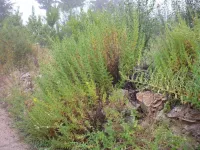
ELSE PRESS RELEASES FROM THIS DATE:
2021-01-13
New probes allow scientists to see four-stranded DNA interacting with molecules inside living human cells, unravelling its role in cellular processes.
DNA usually forms the classic double helix shape of two strands wound around each other. While DNA can form some more exotic shapes in test tubes, few are seen in real living cells.
However, four-stranded DNA, known as G-quadruplex, has recently been seen forming naturally in human cells. Now, in new research published today in Nature Communications, a team led by Imperial College London scientists have created new probes that can see how G-quadruplexes are interacting ...
2021-01-13
On April 15, 2020, a brief burst of high-energy light swept through the solar system, triggering instruments on several NASA and European spacecraft. Now, multiple international science teams conclude that the blast came from a supermagnetized stellar remnant known as a magnetar located in a neighboring galaxy.
This finding confirms long-held suspicions that some gamma-ray bursts (GRBs) - cosmic eruptions detected in the sky almost daily - are in fact powerful flares from magnetars relatively close to home.
"This has always been regarded as a possibility, and several GRBs observed since 2005 have provided tantalizing evidence," said Kevin Hurley, a Senior Space Fellow with the Space Sciences Laboratory at the University of California, Berkeley, ...
2021-01-13
While most children need to show immunization records to attend school, the same may not be true for camps, a new study suggests.
Nearly half of summer camps surveyed by researchers didn't have official policies requiring campers be vaccinated, according to findings led by Michigan Medicine C.S. Mott Children's Hospital in END ...
2021-01-13
KANSAS CITY, MO--What if the degenerative eye conditions that lead to glaucoma, corneal dystrophy, and cataracts could be detected and treated before vision is impaired? Recent findings from the lab of Investigator Ting Xie, PhD, at the Stowers Institute for Medical Research point to the ciliary body as a key to unlocking this possibility.
Previous work from the lab showed that when mouse stem cells were differentiated into light-sensing photoreceptor cells in vitro, and then transplanted back into mice with a degenerative condition of the retina, they could partially restore vision. However, the transplanted photoreceptors only lasted three to four months.
"You cannot cure the condition in a diseased eye if you don't know what ...
2021-01-13
Scientists in China and Sweden have determined that a pinch of capsaicin, the chemical compound that gives chili peppers their spicy sting, may be a secret ingredient for more stable and efficient perovskite solar cells. The research, published January 13 in the journal Joule, determined that sprinkling capsaicin into the precursor of methylammonium lead triiodide (MAPbI3) perovskite during the manufacturing process led to a greater abundance of electrons (instead of empty placeholders) to conduct current at the semiconductor's surface. The addition resulted in polycrystalline MAPbI3 solar cells with the most efficient charge transport to date.
"In the future, green and sustainable forest-based biomaterial ...
2021-01-13
NEW YORK, January 13, 2021 -- Many animal and insect species use Batesian mimicry -- mimicking a poisonous species -- as a defense against predators. The common palmfly Elymnias hypermnestra -- a species of satyrine butterfly that is found throughout wide areas of tropical and subtropical Asia -- adds a twist to this evolutionary strategy. The females evolved two distinct forms, either orange or dark brown, imitating two separate poisonous model species, Danaus or Euploea. The males are uniformly brown. A population group is either entirely brown (both males and females) or mixed (brown males and orange females).
David Lohman, ...
2021-01-13
The iconic, prehistoric dire wolf, which prowled through Los Angeles and elsewhere in the Americas over 11 millennia ago, was a distinct species from the slightly smaller gray wolf, an international team of scientists reports today in the journal Nature.
The study, which puts to bed a mystery that biologists have pondered for more than 100 years, was led by researchers from UCLA, along with colleagues from Durham University in the U.K., Australia's Adelaide University and Germany's Ludwig Maximilian University.
"The terrifying dire wolf, a legendary symbol of Los Angeles and the La Brea Tar Pits, has earned its place among the many large, unique species that went extinct at the end of the Pleistocene ...
2021-01-13
Mutations that occur in certain DNA regions, called tandem repeats, may play a significant role in autism spectrum disorders, according to research led by Melissa Gymrek, assistant professor in the UC San Diego Department of Computer Science and Engineering and School of Medicine. The study, which was published in Nature on Jan. 14, was co-authored by UCLA professor of human genetics Kirk Lohmueller and highlights the contributions these understudied mutations can make to disease.
"Few researchers really study these repetitive regions because they're generally non-coding--they do not make proteins; their function is ...
2021-01-13
Extinct dire wolves split off from other wolves nearly six million years ago and were only a distant relative of today's wolves, according to new research published in Nature today (13 January).
Dire wolves, made famous in the TV show Game of Thrones, were common across North America until around 13,000 years ago, after which they went extinct.
The study shows that dire wolves were so different from other canine species like coyotes and grey wolves that they were not able to breed with each other. Previous analyses, based on morphology alone, had led scientists to believe that dire wolves were closely related to grey wolves.
The research was led by Durham University in the UK alongside scientists at the University of Oxford, Ludwig Maximilian University in ...
2021-01-13
New York, NY--January 13, 2021--Researchers at Columbia Engineering report today that they have developed the first nanomaterial that demonstrates "photon avalanching," a process that is unrivaled in its combination of extreme nonlinear optical behavior and efficiency. The realization of photon avalanching in nanoparticle form opens up a host of sought-after applications, from real-time super-resolution optical microscopy, precise temperature and environmental sensing, and infrared light detection, to optical analog-to-digital conversion and quantum sensing.
"Nobody has seen avalanching behavior like this in nanomaterials before," said James Schuck, associate professor of mechanical engineering, who led the study published today by Nature. "We ...
LAST 30 PRESS RELEASES:
[Press-News.org] Compound from medicinal herb kills brain-eating amoebae in lab studies

